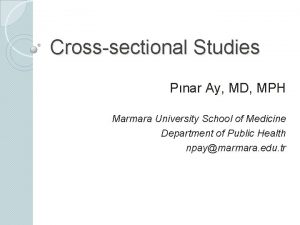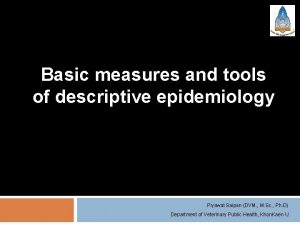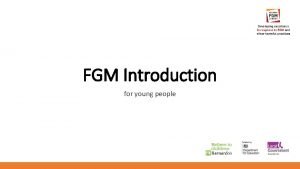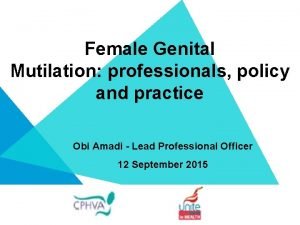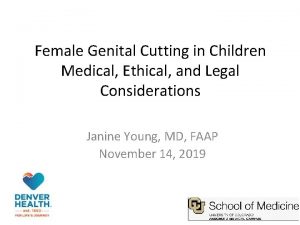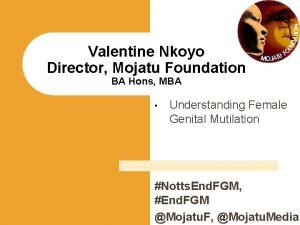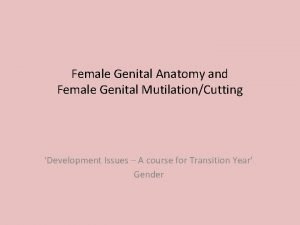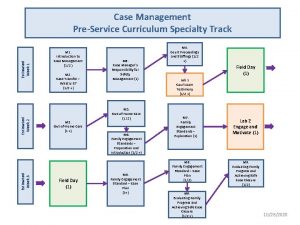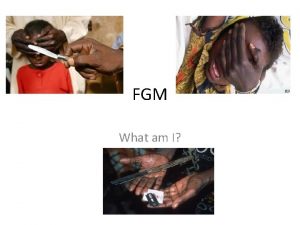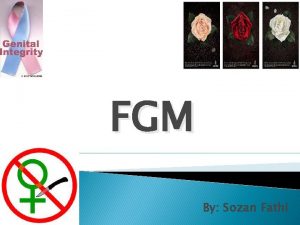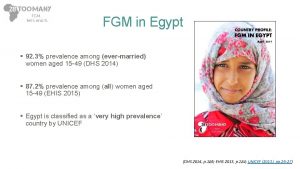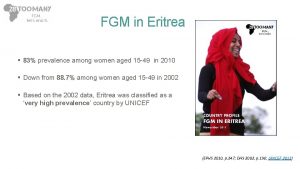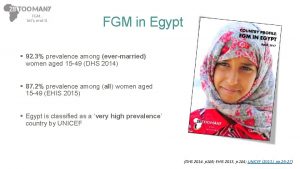FGM IN NIGERIA In Nigeria the estimated prevalence













- Slides: 13

FGM IN NIGERIA • In Nigeria, the estimated prevalence of FGM among women and girls aged 15 to 49 is 24. 8% • 20 million women and girls in Nigeria have undergone FGM • This represents 10% of the global total

FGM PREVALENCE Highest FGM prevalence: South East Zone = 49% South West Zone = 47. 5% Osun State = 76. 6% Lowest FGM prevalence: North East Zone = 2. 9% Katsina State = 0. 1% (DHS 2013, pp. 349 -50)

FGM PREVALENCE BY PLACE OF RESIDENCE URBAN: RURAL: 32. 3% of women aged 15 to 49 years 19. 3% of women aged 15 to 49 years 16. 8% of girls under 14 years 17% of girls under 14 years

REASONS FOR PRACTISING FGM • Main reason – ‘preserve virginity / prevent extra-marital sex’. • Cited by 11. 2% of women and 17. 3% of men who had heard of FGM in Nigeria (DHS 2008), particularly in the oldest age group (45 -49 years). • Women then cited ‘social acceptance’ and ‘better marriage prospects’ as reasons for FGM. • ‘More sexual pleasure for a man’ was cited by men too.

RELIGION - A REASON FOR FGM IN NIGERIA? • Although FGM is not required by any religious script, overall 15% of women and 23. 6% of men believe it is required by their religion. • This is particularly amongst men (39. 9%) and women (33. 1%) practising traditional religions and men (30%) practising Islam (DHS 2013, p. 359)

AGE OF CUTTING • FGM is most likely to take place in Nigeria before a girl reaches the age of 5 • Girls are less likely to be cut after the age of 15 • 16% of girls aged 0 to 14 undergo FGM before their first birthday • 82% of women aged 15 to 49 who have had FGM state that they were cut before the age of 5 (DHS 2013, pp. 352 -3)

TYPES OF FGM • Women aged 15 -49 who had experienced unclassified Type IV FGM include: Ø 24. 9% Angurya (scraping of tissue surrounding the opening of the vagina) Cut, no flesh removed/nicked 5. 8% Cut, flesh removed 62. 6% Sewn closed (infibulation/Type III FGM) 5. 3% Undetermined/Not sure/Don’t know 26. 3% Ø 5. 1% Gishiri (cutting of the vagina) Ø 5. 1% use of corrosive substances • Among girls aged 0 to 14 who undergo FGM, 2. 7% are ‘sewn closed’ (i. e. infibulated – Type III) • Type III is highest among women of Catholic, Christian and traditional religions • Angurya and Gushiri (Type IV) are most common among Muslim women (All data DHS 2013)

PRACTITIONERS • 86. 6% of girls and 79. 5% of women are cut by “traditional agents. ” • The majority of these agents were what the DHS calls “traditional circumcisers”. • 2. 5% of these girls and 7% of these women were cut by “traditional birth attendants. ” (DHS 2013, p. 357). • Medical professionals (doctors, nurses/midwives, other health professionals) cut 11. 9% of girls and 12. 7% of women (DHS 2014, p. 357). • Suggests that medical professionals may now be used slightly less often and ‘traditional agents’ more?

LAW • May 2015 – Violence Against Persons Prohibition Act (VAPP) • Federal law banning FGM and other harmful traditional practices (HTPs) • Only applies to the Federal Capital Territory (FCT) of Abuja. • Up to each of the 36 States to pass similar legislation in their territory • 13 States already have similar laws in place

ATTITUDES TO FGM • Overall, 64. 3% of women and 62. 1% of men believe that FGM should be stopped in Nigeria • Strongest support for an end – 76. 2% - amongst women who have not undergone FGM • 50% support for an end amongst those who have undergone FGM • Attitudes towards FGM amongst women also vary according to residence, education and wealth

WHAT IS THE DATA TELLING US? • From available data the prevalence of FGM appears to be highest among wealthier, better-educated Nigerian women who live in urban areas • Prevalence of FGM appears to be lowest among poorer Nigerian women with little or no education who live in rural areas • These same women are the least likely to have their daughters cut before the age of 15 • These women are more likely to have their daughters cut • This group is also most in favour of ending the practice • This group shows the highest level of support for the continuation of FGM

MOST AT RISK? Ø Poorer Nigerian women Ø Little or no education Ø Living in rural areas

WHAT DO ANTI-FGM PROGRAMMES NEED TO CONSIDER? ü Increasingly mobile population, both socially and economically ü A large, young population with increased access to information through mobile phones ü The inclusion of FGM in the school curriculum is essential ü Awareness raising should take place among men and boys, as well as women and girls ü Engagement of those in public office (at all levels) ü Increased involvement of faith traditional and faith leaders ü Support traditional practitioners of FGM to give up a practice ü Continued and expanded use of media tools ü Involvement of key public figures to appeal to the younger generation ü Set up a network at Federal level, with State-level subsidiaries, to facilitate exchanges of information and ideas
 Epidemiology defination
Epidemiology defination Period prevalence vs point prevalence
Period prevalence vs point prevalence Period prevalence vs point prevalence
Period prevalence vs point prevalence Period prevalence vs point prevalence
Period prevalence vs point prevalence Differenza tra cgm e fgm
Differenza tra cgm e fgm Diagram of the women's reproductive organs
Diagram of the women's reproductive organs Removable partial denture slideshare
Removable partial denture slideshare Fgm diagram
Fgm diagram Fgm
Fgm Fgm vtnhj
Fgm vtnhj Female genitalia
Female genitalia Fgm meaning
Fgm meaning Fgm
Fgm It has been estimated that
It has been estimated that

